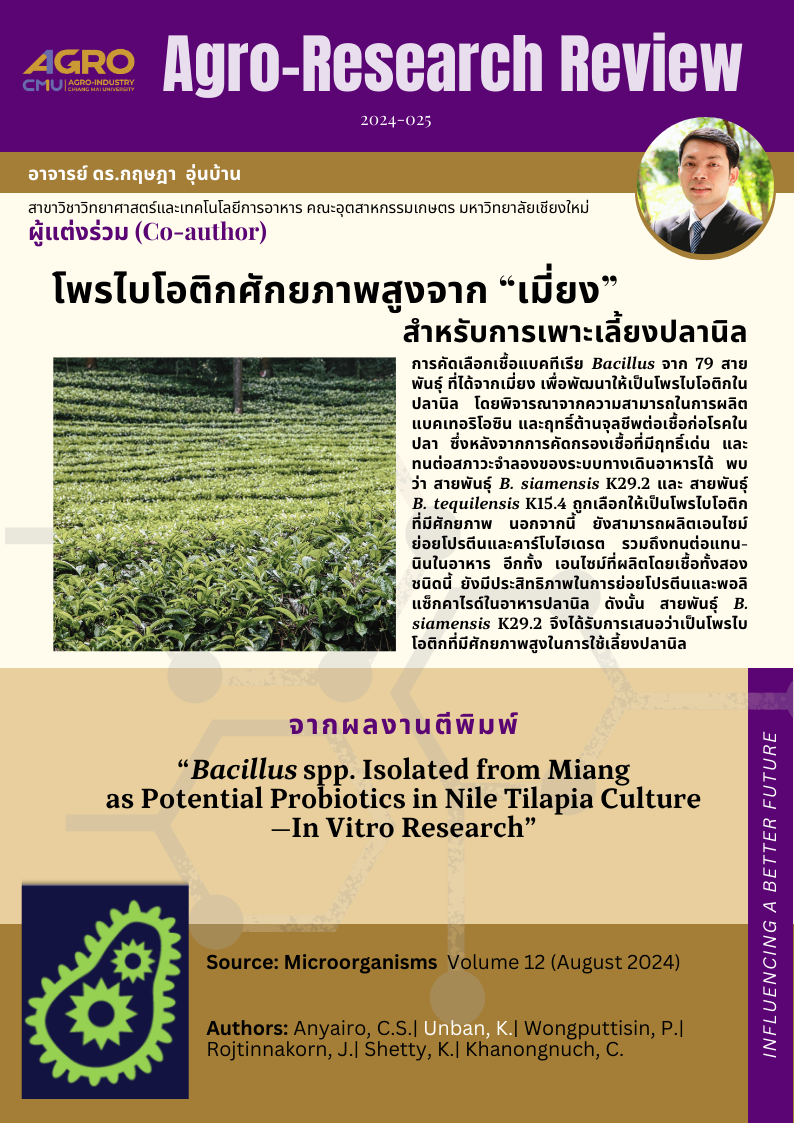
แนะนำงานวิจัย 2024-025 โพรไบโอติกศักยภาพสูงจากเมี่ยงสำหรับการเพาะเลี้ยงปลานิล
การคัดเลือกเชื้อแบคทีเรีย Bacillus จาก 79 สายพันธุ์ที่ได้จากเมี่ยง เพื่อพัฒนาให้เป็นโพรไบโอติกในปลานิล โดยพิจารณาจากความสามารถในการผลิตแบคเทอริโอซินและฤทธิ์ต้านจุลชีพต่อเชื้อก่อโรคในปลา ซึ่งหลังจากการคัดกรองเชื้อที่มีฤทธิ์เด่นและทนต่อสภาวะจำลองของระบบทางเดินอาหารได้ พบว่า สายพันธุ์ B. siamensis K29.2 และ สายพันธุ์ B. tequilensis K15.4 ถูกเลือกให้เป็นโพรไบโอติกที่มีศักยภาพ นอกจากนี้ ยังสามารถผลิตเอนไซม์ย่อยโปรตีนและคาร์โบไฮเดรต รวมถึงทนต่อแทนนินในอาหาร อีกทั้ง เอนไซม์ที่ผลิตโดยเชื้อทั้งสองชนิดยังมีประสิทธิภาพในการย่อยโปรตีนและพอลิแซ็กคาไรด์ในอาหารปลานิล ดังนั้น สายพันธุ์ B. siamensis K29.2 จึงได้รับการเสนอว่าเป็นโพรไบโอติกที่มีศักยภาพสูงในการใช้เลี้ยงปลานิล
Isolation of Bacillus bacteria from 79 strains derived from "Miang" was carried out to develop probiotics for Nile tilapia. The selection was based on their ability to produce bacteriocins and their antimicrobial activity against fish pathogens. After screening for strains with prominent activity and resilience to simulated gastrointestinal conditions, B. siamensis K29.2 and B. tequilensis K15.4 were identified as potential probiotics. Additionally, these strains demonstrated the ability to produce enzymes for digesting proteins and carbohydrates, as well as resistance to tannins in feed. The enzymes produced by both strains were also effective in digesting proteins and polysaccharides in tilapia feed. Therefore, B. siamensis K29.2 has been proposed as a highly promising probiotic for Nile tilapia farming.
Topic: Bacillus spp. Isolated from Miang as Potential Probiotics in Nile Tilapia Culture—In Vitro Research
Authors: Anyairo, C.S.| Unban, K.| Wongputtisin, P.| Rojtinnakorn, J.| Shetty, K.| Khanongnuch, C.
Abstract:
Among 79 Bacillus spp. isolated from Miang, a fermented tea in north Thailand, 17 Bacillus strains were selected with probiotic potential in Nile tilapia culture based on the capabilities of bacteriocin production and associated antimicrobial activities against fish pathogens, Aeromonas hydrophila and Streptococcus agalactiae. However, only six isolates were selected for further extensive studies based on the strength of their antimicrobial activities and their tolerance against simulated gastrointestinal conditions. The molecular identification by 16S rRNA gene sequence analysis revealed that five isolates, K2.1, K6.1, K7.1, K15.4, and K22.6, were Bacillus tequilensis, and the isolate K29.2 was Bacillus siamensis. B. siamensis K29.2 showed complete susceptibility to antibiotics tested in this study, while B. tequilensis K 15.4 showed moderate resistance to some antibiotics; therefore, both strains were selected as potential probiotic bacteria. B. tequilensis K15.4 and B. siamensis K29.2 were capable of the production and secretion of extracellular protease and polysaccharide degrading enzymes, including cellulase, xylanase, and β-mannanase. The tannin tolerant test also demonstrated their ability to grow on selective agar plates and secrete cellulase and β-mannanase in the presence of hydrolyzable tannin. In addition, in vitro digestion of commercial fish substrate revealed that the extracellular enzymes produced by both strains efficiently reacted with feed protein and polysaccharides. Based on the results from this study, B. siamensis K29.2 was deemed to have the highest potential multifunctional probiotic qualities for application in Nile tilapia culture, while the antibiotic-resistant gene in B. tequilensis K15.4 must be clarified before field application.
Keywords: aquaculture; Bacillus; Miang; Nile tilapia; probiotics
View at publisher: https://www.mdpi.com/2076-2607/12/8/1687
#อกมช. #agrocmu #CMU





